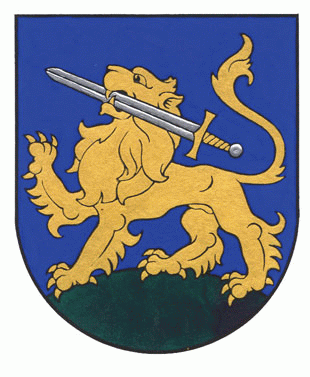 Alternate names: Rietavas [Lith], Riteve [Yid], Retovo [Rus], Retów [Pol], Retowo, Rietevas, Riteva, Ritova, Russian: Ретавас. ריטעווע-Yiddish. 55°44' N, 21°56' E, 21 miles SW of Telšiai (Telz), 13 miles SSE of Plungė (Plungian). 1900 Jewish population: 1,397. Yizkors: Sefer Ritova; gal-ed le-zekher ayaratenu (Tel Aviv, 1977); Choveret Rietova - tosefet lesefer hazikaron (Tel Aviv, 1977); A yizkor book to Riteve, a Jewish shtetl in Lithuania (Cape Town, 2000). ShtetLink. Memorial book: the Ritavas Community. The city is built the first electric power station in Lithuania in 1892 nand had the first telephone line. [March 2009]
Alternate names: Rietavas [Lith], Riteve [Yid], Retovo [Rus], Retów [Pol], Retowo, Rietevas, Riteva, Ritova, Russian: Ретавас. ריטעווע-Yiddish. 55°44' N, 21°56' E, 21 miles SW of Telšiai (Telz), 13 miles SSE of Plungė (Plungian). 1900 Jewish population: 1,397. Yizkors: Sefer Ritova; gal-ed le-zekher ayaratenu (Tel Aviv, 1977); Choveret Rietova - tosefet lesefer hazikaron (Tel Aviv, 1977); A yizkor book to Riteve, a Jewish shtetl in Lithuania (Cape Town, 2000). ShtetLink. Memorial book: the Ritavas Community. The city is built the first electric power station in Lithuania in 1892 nand had the first telephone line. [March 2009]
CEMETERY: JOWBR burial list: Jewish Cemetery [March 2009]
MASS GRAVES: On June 22, 1941, the Jews of Rietavas evacuated the town and sought refuge in surrounding villages when the Germans invaded Lithuania. The next day, the Russians set fire to the town as the Jews retreated. Most houses belonged to Jews and were burned. The Roman Catholic priest formed the Lithuanian activists (commandos) and ordered the Jews to return to the town, forbidding anyone to help them and promising the Jewish property and possessions to those who complied. The municipality listed all the Jews of the town; all adult Jewish males were sent into forced labor. On June 26, the men were led to a small, thick forest by armed SS troops and forced to run in a circle with physical exercises. Failure to perform brought severe and brutal beatings. On June 27, all the Jews of Rietavas--men, women, children, elderly, invalids and the ill--were put into a camp on the Oginsky Convent grounds. Held for three days with no food and water, on the fourth day the SS threw dry rusks and salty smoked fish found in the stores of the Red Army into the camp. The starving Jews fell on this food using empty food tins from the refuse dump as utensils. Many developed diarrhea and severe cramps, but the SS frequently whistled to bring everyone to another round of physical exercise and torment. The white-bands tortured, humiliated, and murdered the rabbi and six young Jews suspected of being communists. They were forced to dig pits and then were either burned or stabbed to death and thrown into the pit. A few days later, the Jews were moved to Telsiai, the regional capital, by forty farm wagons. Before leaving where Jews lived for centuries, they were ordered to hand over their valuables. Wagons took the sick, old, invalids, and small children. The rest marched behind escorted by a massive white-band guard, many Lithuanians, and German photographers. Thirty-six hours later, they reached Camp Reinai where Jews of Telsiai were held. That same evening, they all were transferred to Viesvenai, where 1,500 Jews from Zarenvai, Tverai, and Nevarenai were held. The men and stronger women were sent to forced labor in Telsiai. On July 14 (19 Tamuz), two truckloads of Germans arrived. One German, naked to the waist with a whistle and a whip, ordered the Jews to line up for two hours of horrendous physical exercise, running in a circle, dropping down at the whistle blow, rising up on the next whistle blow. Those unable to keep up were severely beaten, some to death, by this grinning sadist. The next day, a truckload of Germans and Lithuanians arrived. They took fifty strong men, barefoot, with shovels; they never returned, murdered nearby. On Wednesday, two more truckloads of Germans arrived. The Jewish men were tormented and beaten with even more cruelty. After tormenting exercise, the Jews were completely exhausted and without will to live; everyone was led to a woods. Some attempting to escape on the way were shot. During the murder of the men, a German circulated among the women syaing,"You will never see your husbands again and now you have to work very hard. I promise in the name of the Holy One that nothing more will happen to you." One woman defied them for which her child was choked to death and she murdered. After that, the remaining women and children were moved to Giroliar, where they died with Jews from Telsiai region at a camp entirely for women. Medical, health, and other conditions were beyond horrid. A camp committee protested, but the Lithuanians abused the women continuously. Women selected for forced labor were subjected to molestation. The day before the final aktion, the camp commander told the women that something unpleasant would befall them if they did not raise 10,000 rubles. Everything of value was given to the camp commander. The drunken guards broke into the bungalows and assembled all the women with shouts and blows to separate out all women aged 15 to 30. Six hundred women were taken to the new ghetto in Telsiai. The remainder were murdered at Reinai on August 30. At the end of December, between Christmas and New Year, the Telsiai Ghetto was closed when the women were taken to Reinai to be murdered. Some managed to escape to the Siaulai Ghetto. About 30 hid in the area and survived until they were rescued by the Red Army in 1944. According to Lithuanian Jewry, 868 victims of Rietavas are buried in mass graves outside Telsiai at Giroliar and Viesvenai. [March 2009]
Trucks filled with Jews from Pajuris, Shvekshna, Veivirzenai, Rietava, Kvedarna, and Laukuva were brought to Heidekrug labor camp, about 15 km from Neishtot, and shot and buried. [March 2009]
